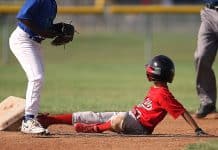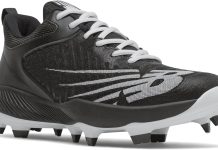Have you ever found yourself standing in a sporting goods store, staring at a pair of cleats, wondering if they are meant for baseball or football? It can be a confusing task to determine the purpose of those cleats without any guidance. In this article, we will help you understand the key differences between baseball and football cleats, enabling you to confidently make the right choice for your specific needs. So, before you step onto the field, let’s dive into the world of sports footwear and uncover the telltale signs that will ensure you never mix up your baseball and football cleats again.
Introduction
Choosing the right cleats for your sport can greatly impact your performance on the field. Whether you’re playing baseball or football, having the appropriate cleats can make a world of difference. In this article, we will explore the key differences between baseball and football cleats, including their material, design, sports-specific features, usage considerations, fit and comfort, expert opinions, and adjustments and accessories. By the end of this comprehensive guide, you’ll be equipped with the knowledge to confidently determine whether your cleats are best suited for baseball or football.
Material
Review contents
Upper
The upper part of a cleat is responsible for providing support and protection to your foot. Baseball cleats typically feature a leather or synthetic upper that offers durability and breathability. Football cleats, on the other hand, often have a synthetic upper with additional padding and reinforcements to ensure stability and protection during intense gameplay.
Outsole
The outsole of a cleat is the part that comes into direct contact with the playing surface. Baseball cleats usually have a hard rubber or metal outsole with cleats that are evenly distributed throughout the bottom for optimal traction on dirt or grass fields. Football cleats, however, have a more aggressive traction pattern with larger, detachable cleats to provide grip on various surfaces, including grass and artificial turf.
Cleat Type
The type of cleat used in baseball and football varies significantly. Baseball cleats typically have metal or rubber spikes that dig into the ground, providing excellent traction for quick turns and bursts of speed. Football cleats, on the other hand, have detachable cleats that can be adjusted based on the playing surface and weather conditions. The ability to change cleats allows football players to adapt to different field conditions and optimize their performance.
Design
Shape of the Cleats
The shape of cleats can differ between baseball and football cleats. Baseball cleats typically have a diamond-shaped toe cleat, which adds stability when running on dirt or grass surfaces. Football cleats, on the other hand, often have a more pointed shape to allow for quick changes in direction and acceleration on various turf types.
Traction Pattern
The traction pattern on cleats is specifically designed to provide optimal grip during gameplay. Baseball cleats have cleats that are evenly distributed throughout the outsole, allowing for stability and traction when running or making quick movements on the field. Football cleats, on the other hand, often have a more aggressive traction pattern with strategic placement of larger, detachable cleats to provide superior grip and prevent slipping on different surfaces.
Ankle Support
Ankle support is crucial in both baseball and football to prevent injuries and maintain stability. Baseball cleats typically offer ankle support through the design of the upper, providing a snug fit and stability during lateral movements. Football cleats often have additional padding around the ankle area to protect against tackles and provide extra support during intense contact.
Sports-Specific Features
Baseball Cleat Features
Baseball cleats often come with specific features to enhance performance on the diamond. Some baseball cleats have reinforced toe caps to protect against impacts when sliding or diving. Others may have extra cushioning in the midsole for shock absorption during running or jumping. Additionally, some baseball cleats have a more flexible design to promote natural foot movements and agility on the field.
Football Cleat Features
Football cleats are typically designed with features that cater to the demands of the gridiron. Many football cleats have reinforced toe boxes and midsoles to withstand the physical demands of the game. Some football cleats also come with extra ankle support and cushioning to ensure stability and reduce the risk of injuries from tackles and collisions. Additionally, some football cleats have built-in technology such as lightweight materials or ventilation systems to enhance performance and comfort during long games.
Usage
Playing Surface
Determining whether your cleats are suitable for baseball or football can be as simple as considering the playing surface. Baseball is traditionally played on dirt or grass fields, so cleats with metal or rubber spikes designed for traction on these types of surfaces are ideal. Football, however, can be played on various surfaces, including natural grass, artificial turf, or indoor fields. As a result, football cleats with detachable and adjustable cleats are necessary to adapt to different playing conditions.
Position
The position you play in your respective sport can also influence the type of cleats you should use. In baseball, different positions may require specific cleat features. For example, outfielders may benefit from metal spikes for better traction and power when sprinting and making quick turns. In football, positions such as linemen may require cleats with more ankle support and reinforced toe boxes to withstand the physical demands of the position.
League Regulations
Different leagues and organizations may have specific regulations regarding the type of cleats allowed. For example, some baseball leagues prohibit the use of metal spikes or dictate the maximum spike length. Similarly, football leagues often have rules regarding the length and type of cleats that can be used to ensure player safety and maintain a fair playing field. Familiarize yourself with the regulations of your league or organization to ensure compliance and avoid penalties.
Comparison
Weight
The weight of cleats can impact your agility and speed on the field. Baseball cleats tend to be lighter in weight compared to football cleats due to the nature of the game. Baseball requires quick movements and agility, so lighter cleats can help players achieve better performance. Football cleats, on the other hand, often have additional padding and reinforcements to provide protection and stability, making them slightly heavier.
Flexibility
Flexibility is another key factor to consider when determining if your cleats are for baseball or football. Baseball cleats often have a more flexible design to allow for natural foot movements, especially during running or fielding. Football cleats, on the other hand, may have a stiffer sole for enhanced stability and support during intense physical contact and directional changes.
Durability
Both baseball and football cleats need to be durable to withstand the demands of their respective sports. Baseball cleats are designed to endure constant running, sliding, and impacts with the ground. Football cleats, on the other hand, need to withstand the physical contact and aggressive movements involved in the sport. Football cleats often have additional reinforcements and padding to enhance durability and protect against wear and tear.
Fit and Comfort
Sizing
Proper fit is crucial for comfort and performance on the field. Baseball and football cleats are typically available in standard shoe sizes, and it’s important to choose a size that provides a snug yet comfortable fit. It’s recommended to try on cleats before purchasing to ensure the correct size, as sizes can vary between different brands and models. If possible, wear the socks you would typically wear during gameplay to ensure an accurate fit.
Width
Foot width can greatly impact the comfort and fit of cleats. Some cleats are designed to accommodate wider feet, while others are more suitable for narrower feet. It’s essential to consider your foot width when selecting cleats to prevent discomfort or blisters during gameplay. If you have wider feet, look for brands or models that offer wider width options to ensure a comfortable fit.
Arch Support
Having proper arch support is crucial for comfort and reducing the risk of foot injuries. Baseball and football cleats may offer different levels of arch support. Some cleats have built-in arch support, while others may allow for the insertion of customized orthotic inserts. Consider your arch type and any specific requirements you have in terms of arch support when choosing cleats.
Expert Opinion
Podiatrist’s Perspective
A podiatrist can offer valuable insight into the importance of choosing the right cleats for your sport. They can assess your foot structure, gait, and any specific foot conditions or concerns you may have. A podiatrist can recommend cleats that provide the necessary support, fit, and functionality for your individual needs, taking into consideration factors such as foot biomechanics, injury prevention, and overall foot health.
Sports Equipment Expert’s Perspective
A sports equipment expert can provide guidance on the technical aspects of cleats specific to baseball and football. They have in-depth knowledge of the latest advancements in cleat technology and can offer recommendations based on your playing style, position, and field conditions. Sports equipment experts can also provide valuable information on the durability, maintenance, and performance benefits of various cleat models and brands.
Adjustments and Accessories
Removable Cleats
Some football cleats have removable studs or cleats, allowing players to customize the traction pattern based on the playing surface. This feature allows for versatility and adaptability, ensuring optimal performance on different types of fields. Baseball cleats, on the other hand, typically have fixed metal or rubber spikes that cannot be removed or adjusted.
Cleat Covers
Cleat covers are accessories designed to protect the spikes or studs of cleats when off the field. These covers prevent damage to other surfaces, such as flooring or bags, while also helping to keep the spikes clean and free from dirt or debris. Cleat covers are particularly useful when transitioning from the playing field to other areas, such as the locker room or car park.
Replacement Spikes
Over time, the spikes or studs on cleats can wear down or become damaged. Replacement spikes or studs are available for both baseball and football cleats, allowing you to prolong the life of your cleats and maintain optimal performance. It’s important to choose the correct size and type of replacement spikes to ensure a proper fit and compatibility with your cleats.
Conclusion
Determining whether your cleats are best suited for baseball or football is crucial for optimal performance and safety on the field. By considering factors such as material, design, sports-specific features, usage considerations, fit and comfort, expert opinions, and adjustments and accessories, you can confidently determine the compatibility of your cleats with your chosen sport. Remember to prioritize features that offer the necessary traction, stability, protection, and support specific to baseball or football, and consult with professionals or experts when needed. With the right cleats, you can maximize your potential and enjoy the game to the fullest.






































